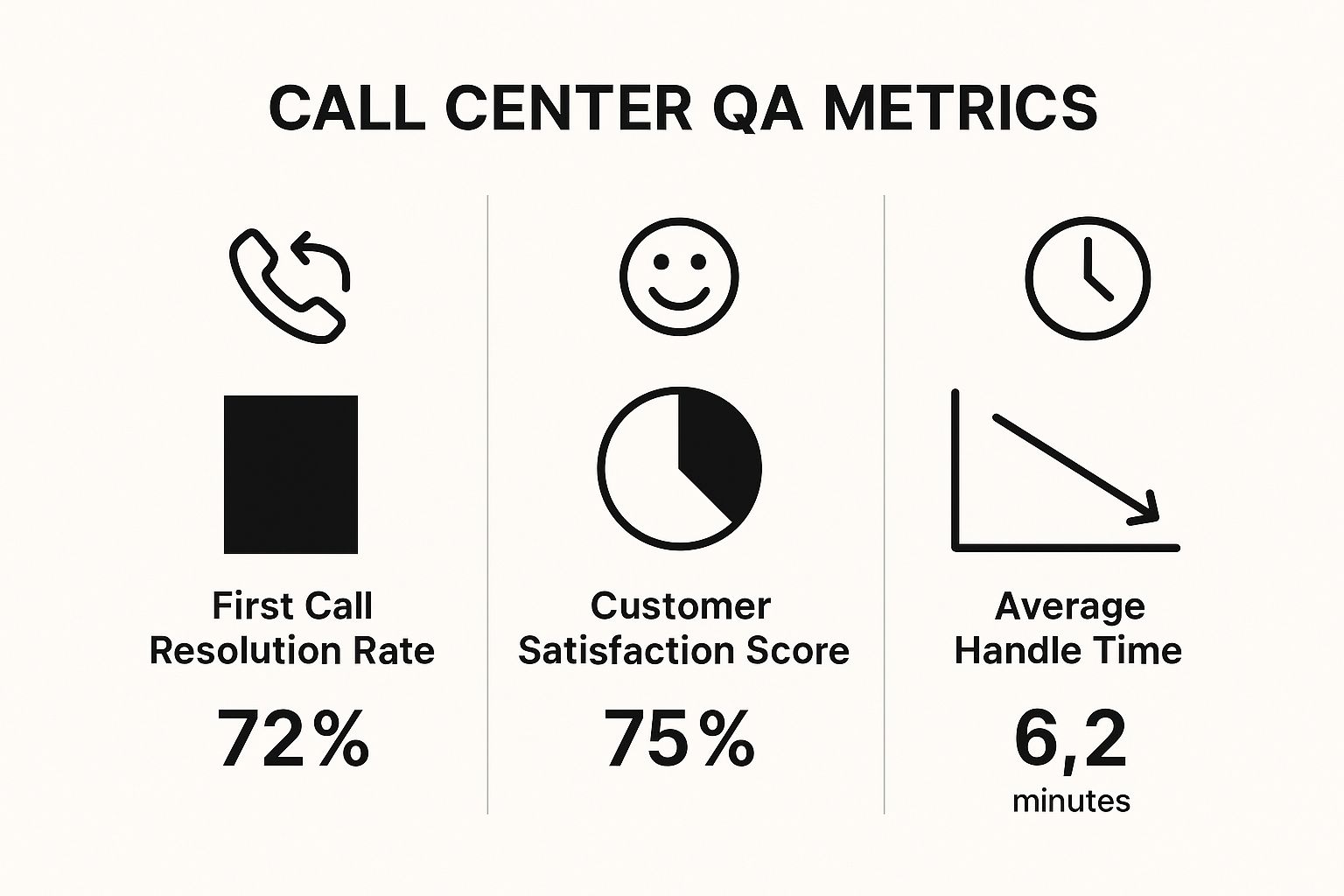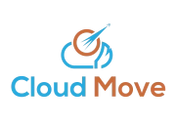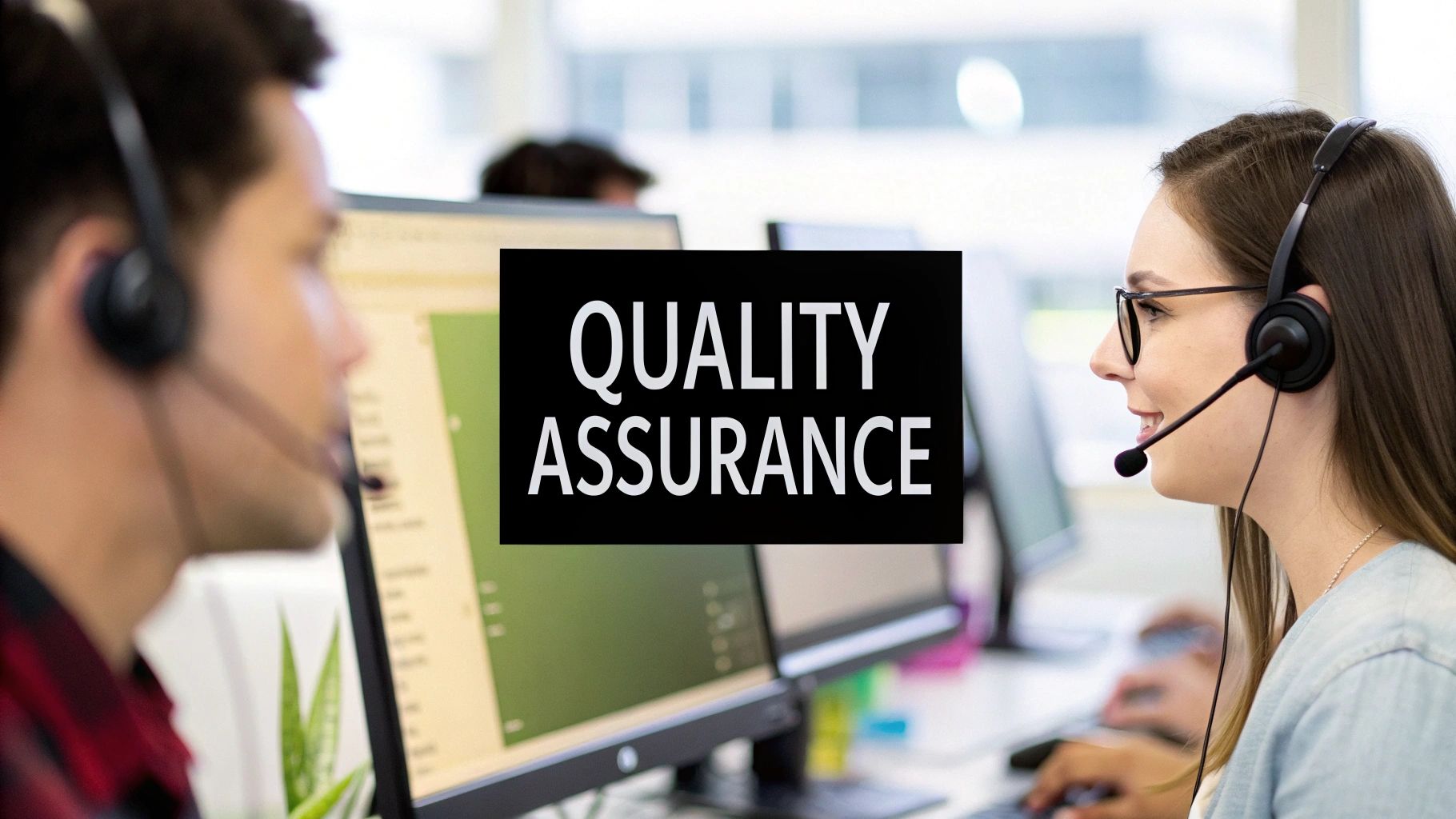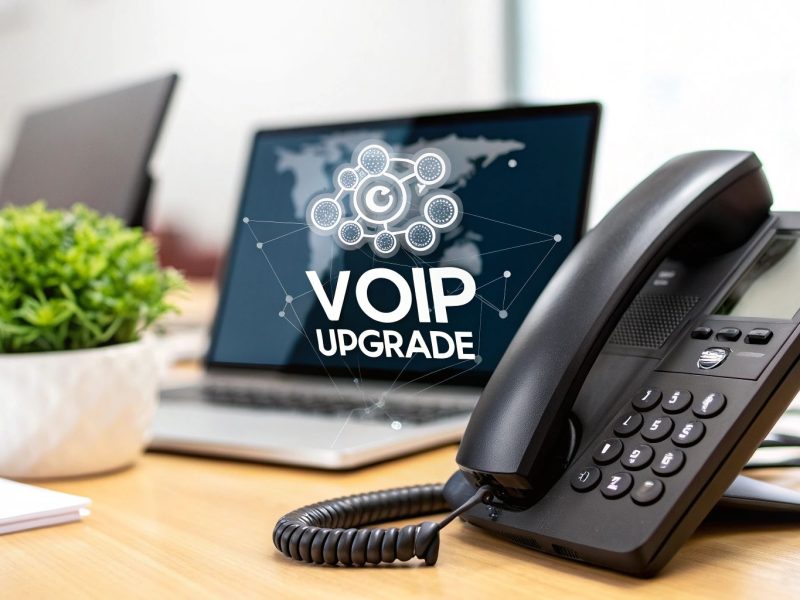The Evolution of Quality Assurance in Modern Call Centers

The Middle Eastern call center landscape is transforming. Quality assurance (QA) is no longer a simple checklist exercise. It has become vital for creating exceptional customer experiences. This shift is driven by significant growth in the region's call center platforms market.
The Middle East and Africa (MEA) market, valued at USD 2060.74 million in 2022, is projected to reach USD 5517.27 million by 2030. This represents a CAGR of 13.10%. This expansion underscores the increasing importance of strong QA programs. These programs ensure customer satisfaction and drive efficient operations.
This rapid growth also presents challenges. These include data security threats and fraud. Consequently, QA must evolve beyond evaluating customer interactions. It now plays a crucial role in protecting sensitive information and businesses. For more detailed statistics, Explore this topic further.
Beyond the Basics: Redefining QA's Role
This growth necessitates a fundamental shift in how we view QA. It's no longer solely about adhering to scripts and meeting basic metrics. Forward-thinking organizations are focusing on the overall customer journey.
Understanding cultural nuances and expectations specific to the Middle East is essential. QA must shift from simply measuring compliance to driving measurable business outcomes. These outcomes include increased customer lifetime value and reduced churn.
The Human Element: Balancing Technology with Empathy
Technology is transforming QA. However, the human element remains paramount, particularly in the Middle East. Personalized interactions and cultural sensitivity are highly valued in the region.
Successful call centers balance the efficiency of AI-powered tools with the empathy of skilled agents. While technology streamlines processes, it must not compromise the personal connection crucial for building customer relationships.
Measuring Success: Quantifying the ROI of Quality Initiatives
Demonstrating the return on investment (ROI) of QA programs is critical. Leading organizations are developing methods to quantify the impact of QA initiatives on key business metrics.
This includes tracking customer satisfaction, agent performance, and operational efficiency. By linking QA investments to improved business outcomes, these organizations demonstrate the value of their quality assurance programs. This supports the continued development and refinement of these programs.
Designing QA Frameworks That Actually Drive Results

The infographic above visualizes three key call center QA metrics: First Call Resolution Rate, Customer Satisfaction Score, and Average Handle Time. Balancing efficiency with positive customer experiences is crucial for effective quality assurance. A high First Call Resolution Rate contributes directly to increased customer satisfaction, while also minimizing Average Handle Time. This balance is essential for successful QA in the AE region. Understanding key performance indicators is crucial for improving QA. Learn more about key customer service performance indicators.
Balancing Quantitative and Qualitative Assessments
Effective call center quality assurance relies on a thorough understanding of agent performance. This requires balancing quantitative metrics with qualitative assessments. Quantitative data, such as Average Handle Time and First Call Resolution Rate, offer a clear view of efficiency and output. However, these numbers don’t tell the whole story.
For instance, a short Average Handle Time might appear efficient. But it could also indicate that agents are rushing customers and not addressing their needs fully. Qualitative assessments, on the other hand, offer vital insights into the quality of interactions.
This involves evaluating aspects like agent empathy, active listening skills, and rapport-building abilities. QA teams must move beyond simple scorecards and adopt more nuanced evaluation methods. This approach is especially important in the Middle East, where personalized interactions and cultural sensitivity are highly valued.
To illustrate the essential components of a modern QA framework, particularly within the Middle East context, let's examine the following table:
This table outlines the key elements required for a comprehensive quality assurance program in Middle Eastern call centers, comparing traditional approaches with modern best practices.
| QA Component | Traditional Approach | Modern Best Practice | Middle East Considerations |
|---|---|---|---|
| Metrics | Focus on quantitative data (e.g., AHT, FCR) | Balanced approach using quantitative and qualitative data | Include metrics related to cultural sensitivity and personalized service |
| Evaluation | Rigid scorecards | Dynamic frameworks adaptable to regional nuances | Consider language proficiency and understanding of local customs |
| Feedback | Generic, infrequent feedback | Regular, personalized coaching and development | Provide feedback in a culturally appropriate manner |
| Training | Standardized training programs | Targeted training addressing regional customer expectations | Emphasize communication skills relevant to the Middle Eastern context |
| Technology | Basic call recording software | Integrated platforms with advanced analytics and reporting | Leverage technology for real-time feedback and performance monitoring |
This table highlights the shift from traditional, metric-driven QA towards a more holistic approach. Modern best practices emphasize qualitative factors alongside quantitative data, especially crucial in the culturally rich Middle East. This allows for a more comprehensive and nuanced understanding of agent performance.
Aligning Evaluation Criteria with Regional Expectations
Designing effective QA frameworks requires careful consideration of regional customer expectations. In the AE region, cultural nuances significantly influence the perception of good customer service. Demonstrating respect and understanding of local customs can be as important as quickly resolving an issue.
QA frameworks should therefore incorporate criteria that address these regional nuances. This might involve assessing the agent’s ability to use appropriate greetings, demonstrate cultural sensitivity, and adapt their communication style.
Moving Beyond Rigid Scorecards
Traditional QA scorecards often focus on a limited set of metrics, leading to a narrow view of agent performance. They may not capture the complexity of customer interactions in the Middle East, where communication styles and service expectations can differ significantly.
Successful call centers are moving beyond these rigid scorecards. They’re adopting more dynamic frameworks that adapt to changing customer needs. This allows for a more holistic evaluation of agent performance. It ensures quality assurance aligns with the specific cultural context of the AE region. For example, a dynamic framework might evaluate an agent’s ability to adapt to different dialects or cultural backgrounds. You might be interested in: How to master….
Establishing Meaningful Benchmarks
To ensure consistency and measure progress, QA frameworks need meaningful benchmarks. These benchmarks should reflect the unique communication patterns and service expectations of Middle Eastern markets. This may involve analyzing customer feedback, conducting regional surveys, and consulting with local experts.
Additionally, benchmarks should be regularly reviewed and updated to stay relevant and reflect current industry trends. By establishing robust and regionally specific benchmarks, call centers can foster a culture of continuous improvement and drive significant results in quality assurance.
Leveraging Technology To Supercharge Your QA Program

Technology is reshaping quality assurance in call centers, moving us from simple call sampling to powerful performance intelligence. This evolution is particularly noticeable in the Middle East, where leading call centers are adopting advanced technologies to gather more profound insights into customer interactions and improve the overall customer experience.
AI-Powered Analytics: Unlocking Deeper Insights
AI-powered analytics are changing how call centers approach quality assurance. These tools can analyze huge datasets of customer interactions, uncovering patterns and trends that humans would miss. For instance, AI can examine call transcripts to pinpoint recurring customer issues, identify gaps in agent knowledge, and even forecast customer churn. This enables QA teams to address problems proactively.
This is especially valuable in the Middle East, where cultural nuances can significantly influence customer satisfaction. AI can be trained to recognize these nuances, providing useful insights into how cultural factors affect customer interactions. This information can then be applied to enhance training programs, refine scripts, and modify QA processes to better serve diverse customer segments.
Sentiment Analysis: Understanding The Emotional Landscape
Beyond simply analyzing the words used in customer interactions, sentiment analysis explores the emotional landscape. This technology assesses customer emotions by examining voice tone, word choice, and other verbal and non-verbal cues. This data can empower agents to tailor their responses in real-time, improving customer satisfaction and fostering rapport.
Furthermore, accumulated sentiment data reveals broader trends in customer satisfaction, allowing call centers to understand how different factors, such as new product releases or service adjustments, impact customer perception. In the Middle East, where personal connections and cultural sensitivity are highly valued, grasping customer sentiment is especially critical.
Real-Time Monitoring: Empowering Agents In The Moment
Real-time monitoring is another valuable tool reshaping quality assurance. This technology allows supervisors to listen to live calls, giving agents instant feedback and support. This enables immediate corrections, stopping minor problems from becoming major complaints.
In the Middle East, the use of technologies like AI-driven self-assist tools and Interactive Voice Response (IVR) is increasing. This aims to automate interactions and boost first-call resolution rates. While the global average first-call resolution rate hovers between 70% and 75%, 60% of failed attempts are attributed to insufficient data and resources. This regional focus on AI aims to enhance customer experiences, but it also brings security and fraud risks to the forefront. As a result, QA programs must integrate both technology and human elements to deliver superior service. Learn more about Middle East contact center technology. You might be interested in: Cloud Move Service Categories.
Balancing Automation With Human Judgment
While technology plays a vital role in enhancing QA programs, the importance of human oversight remains. AI and automation are powerful, but they cannot replace human judgment in quality evaluation. QA teams should use these technologies strategically, finding a balance between automation and human insight. This ensures quality assessments are accurate, fair, and in line with regional cultural values. This combined approach is essential for building QA programs that not only improve efficiency but also enhance the personal touch crucial for developing strong customer relationships.
Creating a Culture Where Quality Thrives Naturally
Exceptional quality assurance (QA) in call centers extends beyond mere checklists and software. It necessitates cultivating a culture where quality is deeply embedded in every customer interaction. Leading Middle Eastern call centers recognize this, transforming QA from a simple monitoring function into a shared organizational value.
Coaching Approaches That Resonate
Effective coaching is essential for agent development and fostering a quality-focused environment. However, traditional delayed feedback methods often prove inadequate. Leading call centers in the Middle East and Africa (MEA) region are adopting more dynamic coaching strategies that resonate with the local workforce.
This involves providing regular, personalized feedback delivered in a culturally sensitive way. The focus shifts from simply highlighting errors to fostering individual growth and improvement.
- Peer-to-peer learning programs: High-performing agents mentor colleagues, sharing best practices and offering real-time support.
- Culturally sensitive feedback: Considers local communication styles and hierarchical structures to build trust and encourage agent development.
Embracing Feedback and Recognition
Creating feedback systems that agents genuinely value is crucial for continuous improvement. Many Middle Eastern call centers are implementing systems that promote two-way communication.
This allows agents to provide valuable input on QA processes and offer their perspectives on customer interactions. This participatory approach empowers agents, making them feel valued and invested in the overall quality journey.
Recognition programs further enhance this culture of quality. However, these programs must be thoughtfully designed to motivate without fostering unhealthy competition. Some centers are shifting from individual awards to team-based recognition programs. This celebrates collaborative successes and reinforces the shared responsibility for quality.
Empowering Agents Through Engagement and Growth
Engaging agents in the QA process is paramount. Actively involve agents in developing quality criteria, setting benchmarks, and reviewing performance data. This collaborative approach fosters a sense of ownership and a shared understanding of quality standards.
This also serves to align individual performance goals with broader organizational objectives.
Creating clear career pathways that incentivize continuous improvement is also vital. Many leading call centers now offer specialized training programs and leadership development opportunities for agents consistently demonstrating a commitment to quality.
This not only strengthens the QA team but also motivates agents to invest in their professional growth within the organization.
Adapting Global Best Practices
While global best practices offer valuable insights, adapting them to regional cultural values is crucial. Workplace motivation in the Middle East is often influenced by factors such as strong team dynamics, respect for hierarchy, and a desire for professional development. Leading call centers recognize these nuances and adapt their QA strategies accordingly.
This can include incorporating culturally relevant examples in training programs, tailoring feedback approaches to respect hierarchical structures, and designing recognition programs that resonate with regional values.
By integrating global best practices with local cultural understanding, Middle Eastern call centers are building a robust quality assurance culture that thrives organically. This translates into enhanced customer experiences and drives positive business outcomes.
Leveraging Technology for Enhanced Quality
The quality assurance landscape in Middle Eastern call centers is influenced by global best practices, with a growing focus on integrating technology and human oversight. Many organizations worldwide, including those in the MEA region, use quality-specific software and speech analytics for their QA programs. Globally, 73% of respondents use quality-specific software, and 79% utilize speech analytics.
In the Middle East, the emphasis on quality assurance is further underscored by the expanding call center AI market, projected to reach USD 340.1 million by 2030. This growth reflects a strong commitment to enhancing customer interaction quality and addressing unique regional challenges. Find more detailed statistics here.
Navigating Compliance Without Sacrificing Customer Delight

In the Middle East, call centers face a significant challenge: balancing stringent regulatory compliance with delivering outstanding customer experiences. This requires a strategic approach to quality assurance (QA) that seamlessly integrates compliance without sacrificing genuine human interaction. It’s about building a QA framework that supports both adherence to regulations and authentic customer connections.
Building Compliance Into Evaluation Criteria
Effective call center quality assurance begins with clearly defined evaluation criteria. These criteria must not only address regulatory requirements but also encourage authentic customer interactions. For instance, consider evaluating how effectively an agent explains complex regulatory information to a customer with clarity and empathy.
- Compliance-focused criteria: These include specific checks to ensure adherence to data protection laws and industry regulations pertinent to the Arab Emirates region.
- Customer-centric criteria: These evaluate agents' ability to build rapport, demonstrate empathy, and personalize the interaction while remaining compliant.
This dual focus ensures compliance becomes an integral part of excellent customer service, not a separate, cumbersome process.
Training for Internalization, Not Just Recitation
Training programs should go beyond rote memorization of scripts and regulations. The focus should be on helping agents internalize compliance requirements. This deeper understanding allows them to handle complex situations confidently while maintaining a human touch.
This can be achieved through several methods:
- Scenario-based training: Agents practice applying regulations in realistic customer interaction scenarios.
- Interactive workshops: These encourage discussions and problem-solving around compliance challenges.
- Regular refresher courses: These reinforce existing knowledge and address updates to regional regulations.
This approach transforms compliance from a checklist item into a core competency, enabling agents to provide truly helpful and compliant service.
Technology as a Support System
Technology plays a vital role in supporting both compliance and customer experience objectives. AI-powered tools can monitor calls for compliance keywords, identify potential violations, and provide agents with real-time feedback. This proactive approach mitigates risks and allows agents to focus on building customer relationships.
Here are some other technologies that enhance both compliance and customer experience:
- Real-time transcription: Supervisors gain immediate insights into conversations for ongoing monitoring.
- Sentiment analysis: Helps agents understand customer emotions and tailor their responses accordingly, even during compliance-heavy interactions.
- Secure data storage solutions: Ensure sensitive customer information is handled in accordance with regional data protection laws.
By strategically using technology, call centers can strengthen compliance without compromising the personalized service Middle Eastern customers expect.
To better understand the key metrics for measuring call center performance in the region, consult the following table.
To understand the key metrics that Middle Eastern call centers should be tracking for quality assurance, we've compiled the following table which includes industry benchmarks and their corresponding business impact:
Key Performance Indicators for Call Center Quality Assurance
| Metric | Description | Middle East Benchmark | Business Impact | Measurement Frequency |
|---|---|---|---|---|
| First Call Resolution (FCR) | Percentage of customer issues resolved on the first call. | 70-75% | Increased customer satisfaction, reduced operational costs. | Monthly |
| Average Handling Time (AHT) | Average duration of a call. | 3-5 minutes | Improved agent efficiency, reduced call center costs. | Weekly |
| Customer Satisfaction (CSAT) | Measurement of customer satisfaction with the service provided. | 4.5 out of 5 stars | Enhanced customer loyalty, positive brand reputation. | Monthly/Quarterly |
| Compliance Adherence Rate | Percentage of calls that adhere to all relevant regulations. | 95-98% | Minimized legal risks, improved brand trust. | Monthly |
| Agent Attrition Rate | Percentage of agents leaving the call center within a specific period. | 15-20% annually | Reduced recruitment and training costs, improved team stability. | Quarterly/Annually |
This table provides a valuable overview of essential QA metrics, enabling call centers to track their performance, identify areas for improvement, and align their strategies with regional benchmarks. Focusing on these metrics will drive positive business outcomes and enhance customer experience.
Adapting to Regional Nuances
Navigating compliance successfully in the Middle East requires a deep understanding of regional regulations and cultural expectations. Data protection laws, industry-specific requirements, and cultural norms all influence call center operations.
Successful call centers adapt their QA frameworks to these region-specific nuances. They consider how cultural expectations impact communication styles and tailor their training and evaluation processes accordingly. This ensures compliance is handled with cultural sensitivity, further improving the customer experience. This approach allows call centers to meet both regulatory requirements and the unique expectations of the Middle Eastern market, leading to an exceptional customer journey.
The Future of Quality Assurance: Trends Reshaping Excellence
The quality assurance (QA) landscape in Middle Eastern call centers is evolving. New trends are changing how organizations define and achieve service excellence, moving beyond traditional approaches to adopt innovative solutions. This shift is fueled by the growing need for exceptional customer experiences in a competitive market.
Predictive Analytics: From Reactive to Proactive
Predictive analytics is transforming QA from reactive evaluation to proactive improvement. By examining historical data, these tools anticipate customer behavior and identify potential issues before they escalate.
This proactive approach allows call centers to address problems preemptively, optimize staffing, and refine processes for a better customer journey. For example, predictive analytics can pinpoint peak call times, enabling call centers to adjust staff levels and minimize wait times, boosting customer satisfaction.
AI-Augmented Evaluation: Expanding Scope and Accuracy
AI-augmented evaluation is changing quality monitoring by broadening its reach and improving accuracy. AI-powered tools can analyze 100% of customer interactions, uncovering patterns and trends impossible to detect manually. This includes analyzing sentiment, tone, and keywords to gauge customer satisfaction and agent performance.
This in-depth analysis facilitates more targeted coaching, personalized training, and data-driven improvements to QA frameworks. Stay ahead with your call center quality assurance. Use this helpful call center quality assurance checklist.
Omnichannel Assessment: Capturing the Complete Customer Journey
As customer interactions span multiple channels—phone, email, chat, and social media—quality assurance must adapt to encompass the entire customer journey. Omnichannel assessment considers all touchpoints for a holistic view of the customer experience.
This means developing channel-specific evaluation criteria while maintaining consistent quality across all platforms. This comprehensive perspective allows call centers to identify pain points, streamline workflows, and ensure consistent, high-quality service across all channels. See our sitemap for additional resources.
Preparing for the Future: Skills and Frameworks
Leading organizations are preparing their quality teams by developing new skills and updating their quality frameworks. This includes training QA analysts in data analysis, AI interpretation, and omnichannel assessment techniques.
It also means redesigning QA frameworks to incorporate new metrics, address emerging channels, and align with changing customer expectations. This proactive approach equips QA teams to manage the future of customer service excellence.
Ready to improve your call center's quality assurance and elevate customer experience? Explore Cloud Move's solutions for enterprise telephony and cloud-managed contact centers. Visit Cloud Move to learn more and request a free demo.




